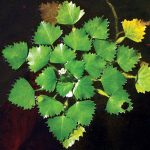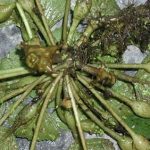Water Chestnut
Identification:
Water chestnut is a rooted, floating plant that invades shallow to deep, fresh water habitats in the northeastern United States, and can be especially prolific in the many ponds of Massachusetts. Water chestnut can grow in up to 15 feet of water and forms dense floating mats, often three layers deep. Leaves on the surface of the water are alternate, triangular in shape, strongly toothed and connected to the stem by an inflated petiole. Submerged leaves are feathery and either opposite or alternate. Dried seed pods are hard and spiney, and sharp enough to penetrate shoes.
The seed pods drift in the water and lodge themselves in areas that produce a plant after two years. In addition to this, a plant dislodged from its seed can grow down and begin to produce a new seed. This aggressive species is a prolific reproducer. 1 acre of water chestnut can produce enough seeds to cover 100 acres the following year. Water chestnut seeds can remain viable in sediments for up to 12 years.
Control:
Small infestations can be hand removed from shore or by boat. Larger infestations may need to be removed mechanically by means of a harvester. Water level adjustment and chemical treatment are also possible methods of control, but require further study of the waterway to assess impact. Please be sure to inspect your canoe, kayak, or boat before leaving a site to prevent spreading this invasive plant to other water bodies. Washing or rinsing the underside at the site is recommended.



